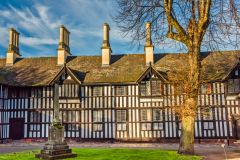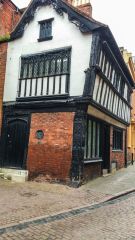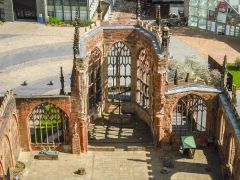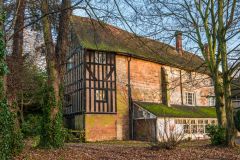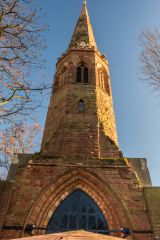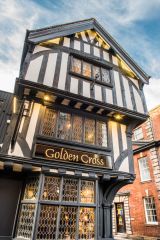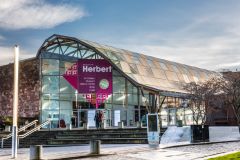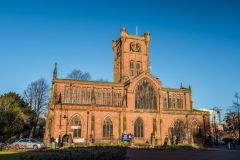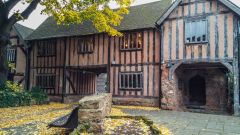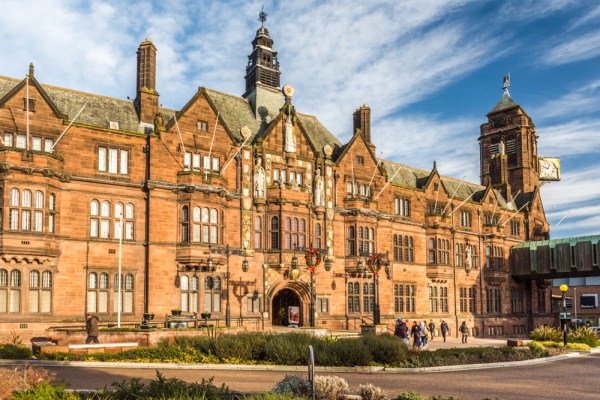
The historic city of Coventry grew up beside the River Sherbourne, on the edge of the ancient Forest of Arden. Probably the first settlement beside the Sherbourne grew up around an early 8th century nunnery founded by St Osburga.
History
The origin of the city name is a matter of debate. Traditional history says that it was a combination of Old English words meaning 'Cofa's tree', a tree marking the boundary of lands owned by a man named Cofa. An alternative explanation is that the name comes from 'Couaentree', a settlement at 'the place where the waters meet' (i.e. at the confluence of the Sherbourne and Radford Brook).
Other theories suggest that the name comes from the Romano-British water deity Coventina, but perhaps the best explanation I have heard is that the name is a combination of 'coven', meaning a convent, and the Celtic word 'tre', meaning a town, or settlement. So you have a town near a convent, which makes sense given the nunnery founded by St Osburga around AD 700.
Coventry really owes its prominence in English history to two people; Earl Leofric of Mercia and his wife, Godiva. Leofric was one of the richest men in the country, and between them, Leofric and Godiva controlled vast estates. They lavished money and estates on Coventry, founding a Benedictine monastery to replace the Saxon nunnery, which had been destroyed by Cnut's Danes in 1016. The monastery became the Priory of St Mary, and the priory church was later raised to cathedral status.
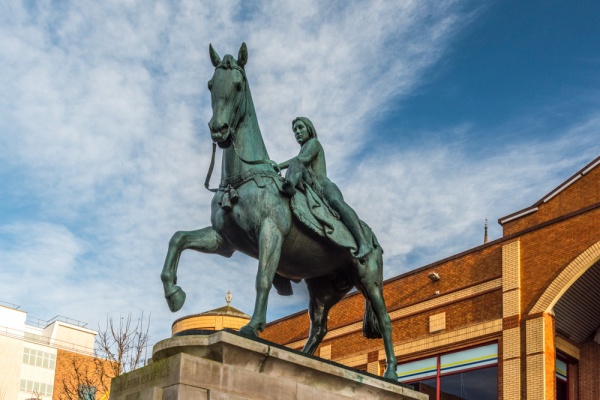
Lady Godiva
The story of Coventry is forever linked to the much-told (and embellished) story of Lady Godiva and her naked ride through the streets of the city. The story has been told and re-told many times, but is based rather loosely upon a very real person. The standard version of events is that Godiva (more properly Godgifu) pleaded with her husband the Earl to revoke crippling taxes imposed on the people of Coventry.
Leofric refused, but in a cruel jest said that he would revoke the taxes only if Godiva rode naked through the streets of Coventry. To his amazement, she did just that. The people of Coventry were commanded to avert their eyes as Lady Godiva rode her horse through the streets of what was then little more than a hamlet.
Only one man, named Tom, disobeyed, earning himself the nickname of Peeping Tom. One version of the story says that the citizens were so outraged by Tom's peeping that they put his eyes out, another that he was struck blind by God as punishment for his voyeurism.
To the Earl's credit, he was true to his word and removed the taxes. Godgifu, or Godiva, was revered by the citizens of Coventry, and a statue of her stands on Broadgate.
Did it happen?
Almost certainly not. The first reference to the story comes well over a century later, in a book by a monk of St Albans known as Roger of Wendover. But that hasn't stopped the story of Lady Godiva from being told and retold over the centuries.
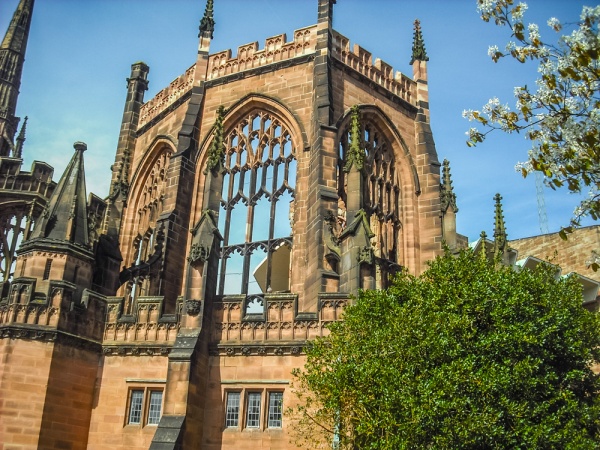
Medieval Coventry
Around 1095 Bishop Robert de Limesey moved the Mercian see from Chester to Coventry. It seemed a peculiar choice; Coventry was then no more than a large village, supporting perhaps 500 residents. His new cathedral was the church of St Mary's Priory, which became both a monastic church and a cathedral. The combination of Godiva and Leofric's patronage of Coventry and the creation of a cathedral was the boost that Coventry needed to become a major urban area over the medieval period.
During the Barons War, when King Stephen and Empress Maud battled for the throne of England, Ranulf Gernons, Earl of Chester, built a castle in Coventry, probably using forced labour to create a fortress just south of where the cathedral ruins now stand. Ranulf's son was Hugh II, who rebelled against Henry II in 1173. Henry crushed the rebellion and damaged the castle so badly that it was never a serious military structure afterwards. It disappears from the historical records in the 16th century.
In 1192 Henry II granted Coventry a Royal Charter, allowing a measure of independent rule, including the right to hold its own courts, encourage land ownership and trade. Coventry flourished as a trading centre and grew in importance throughout the medieval period.
During the early medieval period Coventry was a city of two halves, split into two distinct districts dubbed the 'Prior's Half' and the 'Earl's Half', administered by the Prior of St Mary's and the Earls of Chester respectively.
In 1330 Edward III exiled his mother, Isabella of France, from public life. Isabella took up residence at the royal manor of Cheylesmore, where she turned her attention to restoring the rights of the 'Earl's Half' which had been wrested away by the Prior of St Mary's. Perhaps unwittingly Isabella became a champion of the tenants suffering under the Prior's rule and helped pave the way for a Charter of Incorporation in 1345, which effectively united the two areas of the city under one administrative body.
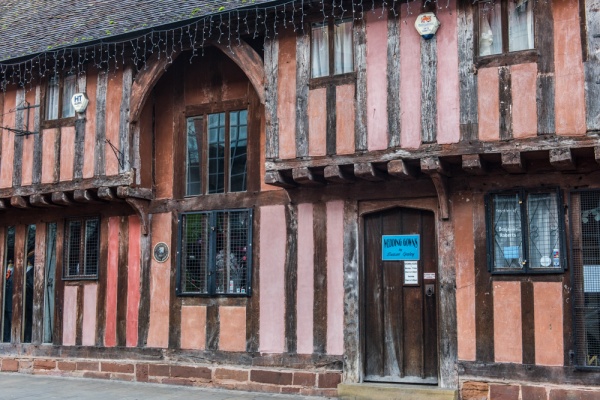
The County of Coventry
By the late medieval period Coventry was at the centre of a thriving textile trade and had become one of the wealthiest cities in England. During the Wars of the Roses Henry VI and Queen Margaret of Anjou took refuge in the city during a rebellion against Henry's rule.
Henry was mindful of the city's support and in 1451 he granted Coventry the status of a county, and for almost the next 400 years the city was the heart of the 'County of the City of Coventry', a territory that took in 20 surrounding villages. The County lasted until 1842, when Coventry reverted to the status of a city within the county of Warwickshire.
Henry suffered from bouts of madness, and during one of those periods Queen Margaret transferred the seat of government to Coventry, and Parliament met at St Mary's Guildhall, beside the cathedral.
We mentioned earlier that the church of St Mary's Priory was both a monastic church and a cathedral. That all changed in 1539 when St Mary's was suppressed by Henry VIII as part of his Dissolution of the Monasteries.
The economic impact on Coventry was enormous, and within a few years, the population of the city fell by more than fifty percent. Most of the monastic buildings were either sold as private dwellings or demolished for building material. One surviving feature is a medieval tower that was later incorporated into the Old Bluecoat School site.
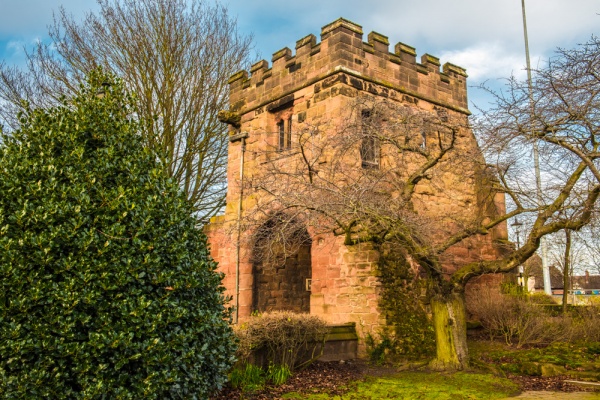
World War Two
On the night of 14 November 1940, the face of Coventry was changed forever. Until that night the centre of Coventry was a delightful maze of timber-framed buildings and medieval alleyways, presenting one of the best-preserved medieval townscapes in Europe.
In one devastating raid, the German Luftwaffe methodically razed the historic centre of Coventry in an eleven-hour raid designed to inflict the maximum damage on the civilian population and, to a lesser extent, on local manufacturing.
Roughly 570 people were killed and another 1200 injured. There were so many dead that individual burials were impossible, and the slain were interred in a mass grave now marked by a Garden of Remembrance. The historic city centre was levelled, and the cathedral, in particular, was beyond restoration.
A Phoenix from the Flames
Yet like the proverbial phoenix, Coventry rose again. The city centre was rebuilt, and a new cathedral constructed beside the ruins of the old. Despite the destruction, a surprising number of historic buildings remain, scattered here and there amidst the modern structures.
Historical Highlights
Coventry has an unfortunate reputation as a modern city, rebuilt from the ashes of the World war Two bombings. I say unfortunate, because the city is bypassed by visitors who imagine that there is nothing much to see of historic interest.
Nothing could be further than the truth.
Though the bombs caused enormous damage and destroyed what was perhaps the best-preserved medieval city in Britain, enough survived to make exploring historic Coventry an absorbing experience. Medieval timber-framed buildings abound and seem to have survived in odd little pockets, surrounded by modern office blocks and shopping areas.
Here are just a few of the major historic highlights that can be reached on foot from the city centre.
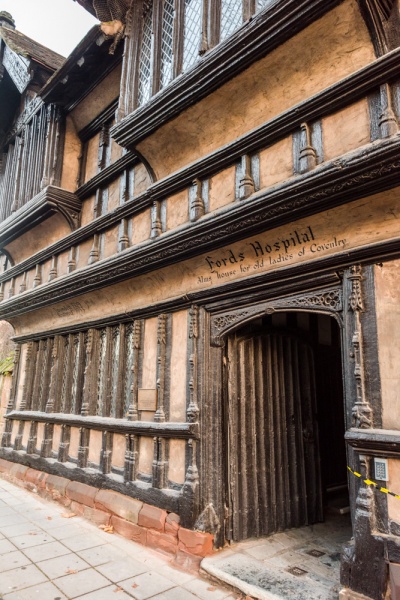
Coventry Cathedral
The most obvious place to start your exploration is the cathedral, also known as St Michael's Cathedral. St Michael's is just one of three cathedrals to have served Coventry over the centuries. The earliest cathedral was founded by Earl Leofric and Lady Godiva in 1043 and a see was established that encompassed Coventry and Lichfield.
During the Dissolution of the Monasteries the see was transferred to Lichfield, and the former cathedral church was allowed to decay. In 1918 a new diocese of Coventry was created and St Michael's church was raised to cathedral status.
The cathedral church was destroyed on 14 November 1940, when the German Luftwaffe raided the city. The church was not rebuilt but preserved as a reminder of the futility and waste of war.
One of the most touching and poignant features of Coventry Cathedral, both new and old, is the focus on reconciliation and fellowship. This emphasis on reconciliation began in 1940, following the cathedral's almost total destruction by German bombs.
Provost Howard made a Christmas Day radio broadcast, vowing that when the war was over he would work to build 'a kinder, more Christ-child-like world'. This vision made the cathedral - new and old - into a world Centre for Reconciliation. As you explore the cathedral you find numerous sculptures emphasising the focus on reconciliation and building bridges between people of all faiths and backgrounds.
The old cathedral is open to the sky, save for the west tower, which was miraculously spared from destruction. The base of the tower now houses the local tourist information centre, and you can purchase tickets to climb to the top of the tower for superb views. The cathedral itself is free to explore.
The New Cathedral
Beside the ruins of the medieval cathedral is the stunning new cathedral, designed by Sir Basil Spence with aide from some of the leading artists and architects of the day. The architecture is unlike any modern - or traditional - English cathedral. Rather than a Church of England sacred space, Coventry's new cathedral is intended for people of all denominations and all faiths to gather together. Unlike the old cathedral beside it, the new cathedral does have an entrance fee.
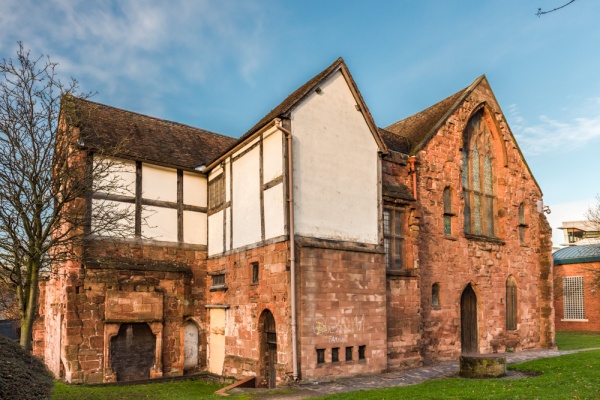
Holy Trinity Church
Just a few short steps from the ruins of St Michael's Cathedral is Holy Trinity Church, one of the most interesting historic buildings in the city. Though the first written record of the church appears in 1113, its history goes back to the foundation of the Priory of St Mary by Leofric and Godiva. The church seems to have been built as a side-chapel for the priory, to be used by the priory's tenants. That late Saxon building was destroyed by fire in 1257, with only the north porch surviving.
Many 13th century features remain, including the spectacular 'Doom', or painting of the Biblical Day of Judgement over the chancel arch. The Doom is breathtaking, but there is much more of interest, including a 1470 stone pulpit carved with likenesses of Henry VI and Queen Margaret, a 'Bishops' Bible' printed around 1570, and a wonderful collection of medieval misericords in the chancel.
Outside the south-east corner of Holy Trinity is a modern replica of Coventry Cross, an ornate Tudor market cross that once stood at the junction of Broadgate and Cross Cheaping. The Cross was taken down in the late 18th century when it became dilapidated, and the replica was completed in 1976.
St Mary's Priory
A few steps north of Holy Trinity and Coventry Cross are the ruins of St Mary's Priory. The Priory was founded in AD 1043 by Earl Leofric and Lady Godiva, on the site of a Saxon nunnery destroyed by Cnut in AD 1016. Leofric was buried here in 1057, and in 1095 the Priory church was raised to cathedral status. The monastic buildings were offered to the people of Coventry when Henry VIII suppressed the Priory, but the citizens could not raise the money to buy the site so the buildings were destroyed.
The Priory remains was rediscovered during construction work on the Old Bluecoat School in 1865, and the area was later excavated, revealing the chapter house, undercroft, and a 14th century 'Apocalypse Mural'. Following the excavation a series of wooden walkways were built over the site to create public viewpoints, and part of the cloisters were turned into a public park.
St Mary's Guildhall
To the south of the old cathedral site is St Mary's Guildhall, which once served as a gathering place for Parliament. The Guildhall was built in stages between 1340-1460, and restored in 1824. It incorporates parts of the 12th-century castle built by Ranulf Gernons, Earl of Chester.
The Guildhall was initially used as a meeting place for the merchant guilds of St Mary and Holy Trinity and became the administrative centre for local government after Coventry became incorporated, as mentioned above. The great hall is still used for functions, and is open to the public throughout the spring and summer months. One highlight is a 16th-century tapestry made by Henry VII, commemorating Henry VI's life and his connection to Coventry.
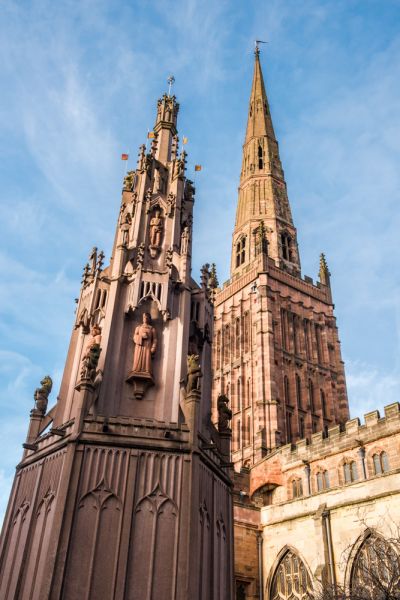
St John the Baptist Church
A brisk 5-10 minute walk from the cathedral brings you to one of Coventry's surviving medieval treasures; the 14th-century church of St John the Baptist, which stands at the eastern end of Medieval Spon Street. The church was founded in 1344 by Isabella of France, who gave a grant of land to the Guild of St John, to be used to erect a chapel for their own services, with two chantry priests to say daily mass for the royal family.
The college of priests was dissolved at the Reformation, and the church stopped being used for worship in the late 16th century. It was used as a prison during the English Civil War, and later as a stable, a market place, and a dyers workshop.
In 1734 it was restored as a place of worship. Most of the interior furnishings are late Victorian and Edwardian, but there are several historic highlights, including a relic of St Valentine of Rome, and a beautifully carved screen and reredos, but the real highlight is the superb 14th-century architecture, with a soaring arcade and clerestory, and a profusion of beautifully carved figures peering down from the arcade arches.
Medieval Spon Street
West from St John the Baptist church stretches Spon Street, boasting the best-preserved collection of medieval buildings in Coventry. The attractive timber-framed buildings are now shops and pubs. Up a path beside the Shakespeare pub is the Coventry Watch Museum, with exhibits covering the long history of watch and clock manufacture in Coventry.
Weaver's House Museum
Just outside the inner ring road in Spon End is a terrace of six 15th-century cottages. One of the cottages has been restored as The Weaver's House, recreating how the building looked around 1540, when it was the home of John Coke, a narrow-loom weaver. See a replica of Coke's loom and experience how he and his family would have lived and worked. Behind the house is a medieval garden, with plants grown for medicinal and cooking purposes.
These are just a few of the major historic sites to explore on foot from the city centre. As you can see, there is a lot of historic interest despite the devastation wrought by World War Two bombs. Coventry deserves a lot more attention as a historic city and an exciting destination for tourists. Our family loved exploring the city and are planning to return.
About Coventry
Address: Coventry,
West Midlands,
England
Attraction Type: Town - City
Location: Access from the M6 or M69 motorways and A45/A46 outer ring road
Website: Coventry
Location map
OS: SP334789
Photo Credit: David Ross and Britain Express
HERITAGE
 We've 'tagged' this attraction information to help you find related historic attractions and learn more about major time periods mentioned.
We've 'tagged' this attraction information to help you find related historic attractions and learn more about major time periods mentioned.
Find other attractions tagged with:
NEARBY HISTORIC ATTRACTIONS
Heritage Rated from 1- 5 (low to exceptional) on historic interest
Coventry Cross - 0.1 miles (Historic Building) ![]()
Coventry, Holy Trinity Church - 0.1 miles (Historic Church) ![]()
Coventry, Lychgate Cottages - 0.1 miles (Historic Building) ![]()
Coventry, St Mary's Priory - 0.1 miles (Abbey) ![]()
Coventry Council House - 0.1 miles (Historic Building) ![]()
Coventry, St Mary's Guildhall - 0.1 miles (Historic Building) ![]()
Coventry, Ford's Hospital Almshouse - 0.1 miles (Historic Building) ![]()
Coventry Cathedral - 0.1 miles (Cathedral) ![]()
Nearest Holiday Cottages to Coventry:
Balsall Common, West Midlands
Sleeps: 9
Stay from: £1111 - 4413
More self catering near Coventry
